Here's the story of a painting.
I started out with a few canvases I'd put together to enter one of those "call for entries" art sweepstakes things where the theme was Erotic Art. I like erotic art -- not that I can define it, exactly, and I'm not even sure I know it when I see it -- and some of my paintings seem to qualify -- not that I think of them that way, exactly -- and I thought this was a show I could get into. I had a few existing paintings I was going to put in, but I wanted to add at least one more. So I mused on the idea of eroticism in painting and I came up with an idea, a vision. Most of my paintings start out with a mental image which I then refine and expand as I feel like.
My plan was to do the painting in a sort of serious academic kind of style, first painting in a monochrome grisaille layer and then glazing over that with transparent colors, then going back in with opaque highlights. Straight out of Joseph Sheppard's How to Paint Like the Old Masters.
I made several mistakes with this painting. The first one was the basic idea. I just don't think it was all that good. The second mistake was using Gamblin's Chromatic Black to make the gray for the underpainting. Chromatic Black is a beautiful color, but it turned out not to work well (for me, anyway) under transparent glazes of skin tones, because everything went all sickly and weird. And then of course there was the basic mistake I often make, which is to proportion my female figure like a linebacker. Rargh, naked model SMASH! And then my final mistake was to cheese out on the background: Originally I planned some kind of curtain or drapery, but I ended up going with this basic Abstract Expressionist kind of blap background instead so that the figures sort of ended up floating in BarnettNewmanSpace.
The painting went badly from the beginning. The figure turned out kind of all wrong no matter what I did. The face never looked human. Proper proportions eluded me. Once the underpainting was dry and I put down my first layer of glaze, I saw it wasn't working, so I wiped the glaze off, only to find it had slightly stained some of the underpainting and would never come off. I tried several different glazing approaches, none of which worked. Paint dripped when I didn't want it to. Paint got gluey when I didn't want it to. Eventually I forced myself to abandon it rather than actually finish it.
Really, all the mistakes were one big mistake, which is that I rushed. I was impatient and I pushed too much and I blundered on through like an idiot and the result was this, which was a truly bad painting.
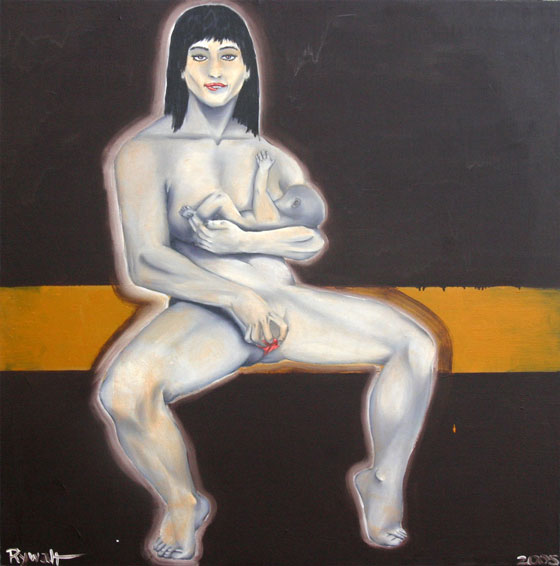
I photographed it digitally and tried to make it look presentable and put it on my CD for the show entry, just because I'd done it and figured I might as well. In the end I didn't get in the show mainly because the judges really liked crap like this guy, but I'm sure my one totally lousy painting amidst my other not so lousy paintings didn't help. It wasn't long before I decided that, out of all the notso hotso paintings I'd saved over the years, this painting would not be one of them. I lost no time titling it "The Lost Painting" and painting over it with a couple of good thick layers of Gamblin Ground so it'd never escape.
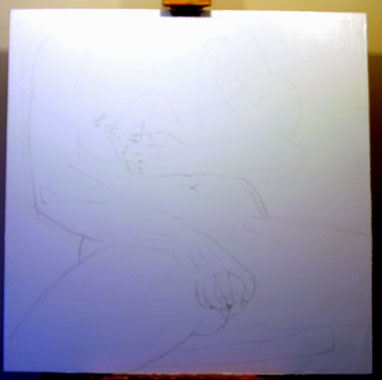 On the newly blank canvas I attempted the idea again. I sketched out a new version of the painting trying to address some of the shortcomings of the original. I enlarged the figure, putting her head and feet off the canvas. I tried to lighten her up so she didn't look like a lacrosse player. And so on. I showed the sketch to my wife and she complained that the woman's right hand still looked like a claw. Okay, I told her, you model for me so I can get it right. She agreed. But time went on and we didn't get around to it, so the blank canvas with its sketch sat around behind my easel doing nothing.
On the newly blank canvas I attempted the idea again. I sketched out a new version of the painting trying to address some of the shortcomings of the original. I enlarged the figure, putting her head and feet off the canvas. I tried to lighten her up so she didn't look like a lacrosse player. And so on. I showed the sketch to my wife and she complained that the woman's right hand still looked like a claw. Okay, I told her, you model for me so I can get it right. She agreed. But time went on and we didn't get around to it, so the blank canvas with its sketch sat around behind my easel doing nothing.
I don't know exactly what happened that day, but whatever it was, I was one cranky bastard. Everyone in the world had pissed me off. I was angry as all hell when I went to the local chain restaurant and ordered take out.
Sitting there steaming, I noticed a waitress standing by the hostess station. Something just caught my eye. Something about the shape of her hair with the colors of the background and the tone of her skin. I stared at her trying to fix the colors in my mind, trying to figure out shade and relative values and things I'm no good at because I have no technical background in color. I stared long enough that she noticed me -- doo-da-doo, I'm not looking at you, just looking at everything, lovely ceiling you have here....
As soon as I got home I went into a frenzy. I ate and then turned on my painting lights and pulled out the only blank canvas I had around. I stood it on my easel upside-down (so the sketch wouldn't distract me) and did something I almost never do: I attacked the canvas with no preparation whatsoever. I was thinking of Picasso in The Mystery of Picasso, putting paint down and making changes and not worrying about making mistakes. All I had as my guide was the vision I wanted to capture from the restaurant.
It became immediately clear that my vision was very, very blurry. I had no idea in my head what I wanted to do with her face. In my head she didn't have a face, just a glimmer of the dim light shining off her lips. On canvas, of course, I had to do something -- you can't just leave it all blank. Well, maybe someone could've, but not me. I painted, I wiped down, I painted, I wiped down, I modified, I modelled, I mixed colors, I wiped down. I attacked the canvas ferociously, energetically, all the time thinking, "There are no mistakes." She insisted on having a face -- very well. She'd have a face. I roughed in vague outlines. I wiped back. I reconsidered. I added. I removed.
Eventually I was exhausted and I cleaned up and went to bed. In the morning I looked at what I'd done and had to conclude: This was the worst thing I'd painted since I was six years old.
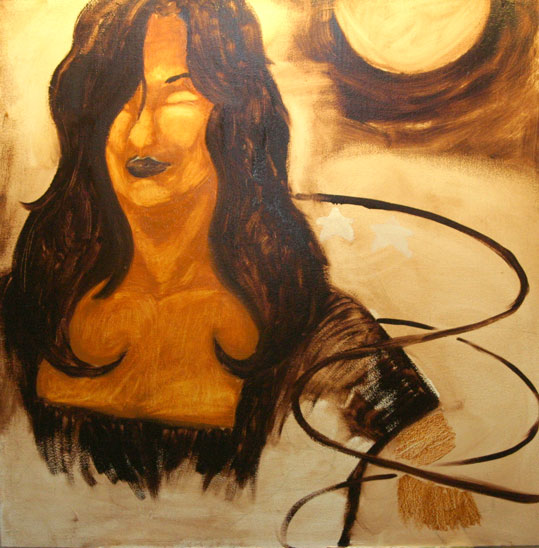
After letting it mull for a few hours and realizing my judgement wasn't going to change, I went at the canvas with a rag soaked in OMS. Alas, most of the paint had set overnight and was now permanent.
I tried to think of what I wanted from this painting, what the vision had offered me that had made it feel important enough to paint. I thought about it -- meditated on it -- and then began, more evenly, to paint directly over what I'd done the night before.
Slowly, what emerged began to look something like what I wanted.
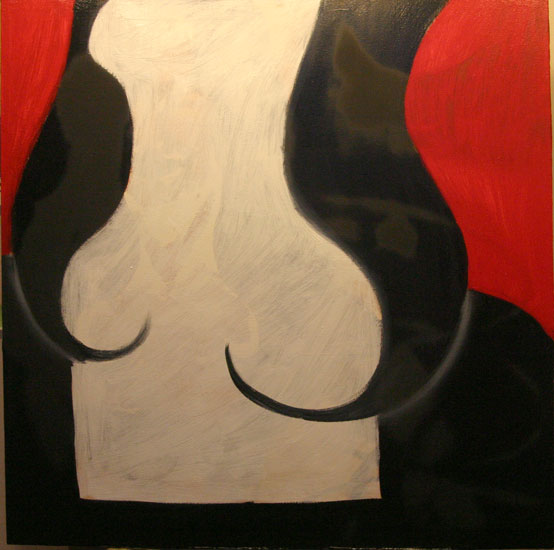
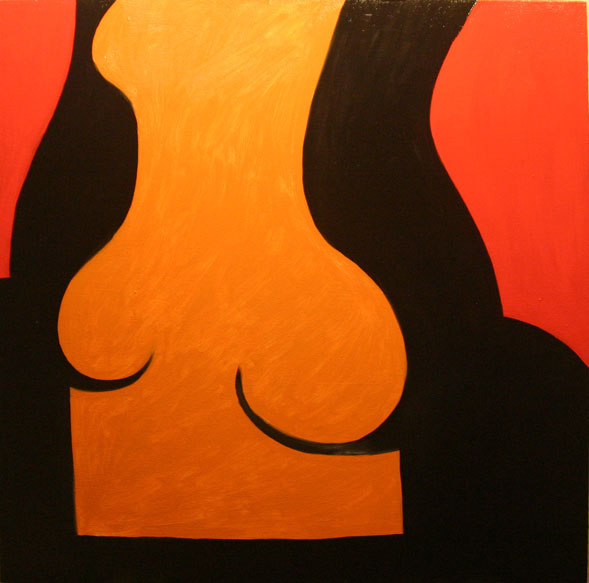
When I reached this point, I liked what I had. But I realized with a start that I did not want to be a hard-edge painter. Not that I have anything against hard-edge painting; but there are plenty of hard-edge painters out there and I just don't need to be one of them. The last touches suggested themselves to me easily, and I let them paint themselves.
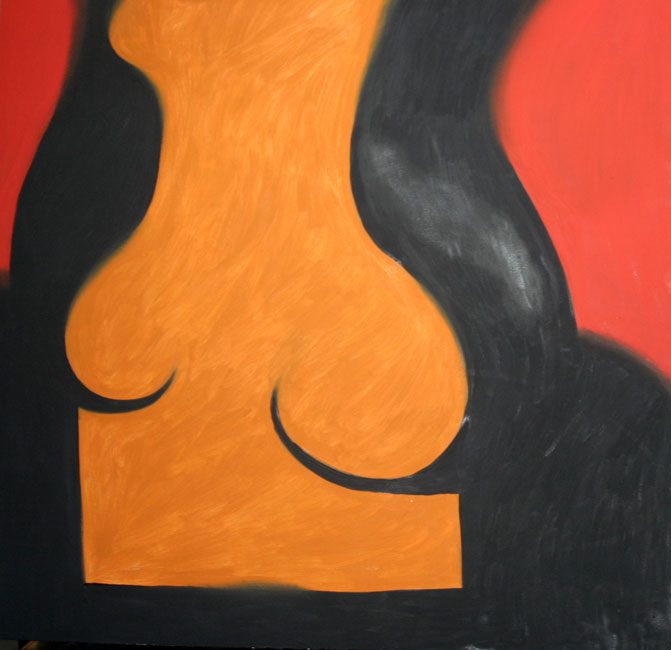
After the paint dried I spent the next few days trying out various things, but in the end I wiped them all off and left what was here. (The whitish shiny area in the photo is from the light glaring off the last spot I wiped down.)
I think this canvas is done now.

